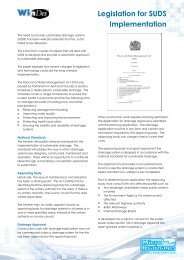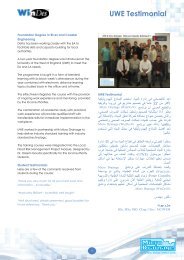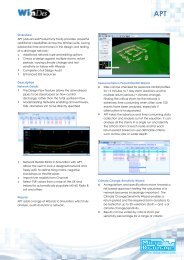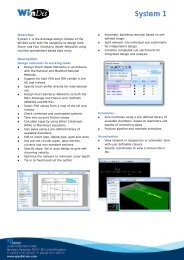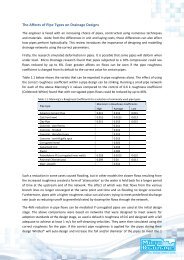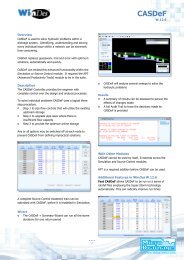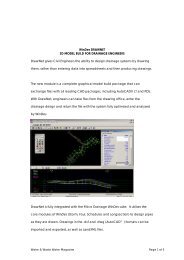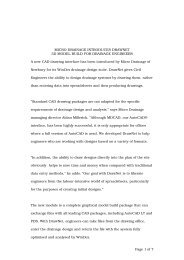Detailed Design of SUDS - Micro Drainage
Detailed Design of SUDS - Micro Drainage
Detailed Design of SUDS - Micro Drainage
You also want an ePaper? Increase the reach of your titles
YUMPU automatically turns print PDFs into web optimized ePapers that Google loves.
<strong>Detailed</strong> <strong>Design</strong> <strong>of</strong> <strong>SUDS</strong><br />
Introduction<br />
In the previous paper site specific details were<br />
strategically analysed.<br />
This paper covers the detailed design <strong>of</strong> an<br />
integrated <strong>SUDS</strong> system.<br />
<strong>Detailed</strong> <strong>Design</strong> Process<br />
The work process comprises <strong>of</strong> five stages;<br />
1) <strong>Design</strong> the surface water flow conveyance<br />
network<br />
2) <strong>Design</strong> the ‘appropriate’ structures for each<br />
sub-catchment<br />
3) Develop the optimum <strong>SUDS</strong> train for the<br />
project<br />
4) Test the <strong>SUDS</strong> train for hydraulic and water<br />
quality performance<br />
5) Model an integrated <strong>SUDS</strong> system<br />
1) <strong>Design</strong> the surface water flow conveyance<br />
network<br />
There are two ways to design the SW network, either<br />
in a graphical or spreadsheet format. The most<br />
productive method would be to use an electronic<br />
drawing, or work in conjunction with GIS data, in a<br />
graphical format.<br />
The drainage layout can be drawn on plan and auto<br />
designed to comply with local standards. Typically<br />
the flow conveyance system would be designed for a<br />
relatively frequent return period <strong>of</strong> 1, 2 or 5 years.<br />
The amount <strong>of</strong> detail imported will depend upon the<br />
CAD drawing. Text, Simple or Complex Cover levels<br />
can be loaded and triangulated.<br />
<strong>Design</strong> <strong>of</strong> the flow conveyance system can be<br />
completed with pipes, swales, ditches and culverts.<br />
The capacity <strong>of</strong> each element is optimised as the<br />
impermeable areas are input.<br />
Details are input as ‘<strong>Design</strong> Criteria’ to ensure the<br />
network is auto designed in accordance with local<br />
requirements.<br />
The outfall details may be included to ensure the<br />
system meets the correct discharge point.<br />
A CAD drawing <strong>of</strong> the infrastructure layout is then<br />
imported, in 2D or 3D format.
<strong>Detailed</strong> <strong>Design</strong> <strong>of</strong> <strong>SUDS</strong><br />
2) <strong>Design</strong> ‘appropriate’ structures for each subcatchment<br />
The benefit <strong>of</strong> planning out the <strong>SUDS</strong> system may now<br />
be fully realised as structures for each <strong>of</strong> the subcatchments<br />
can be developed into a <strong>SUDS</strong> train,<br />
using a ‘<strong>Design</strong> Guide’.<br />
The <strong>Design</strong> Guide is a tool developed to simplify the<br />
complex process <strong>of</strong> designing<br />
the optimum solution for a<br />
project that incorporates the<br />
use <strong>of</strong> infiltration techniques.<br />
3) Develop the optimum <strong>SUDS</strong> train for the<br />
project<br />
The optimum structure for each sub-catchment is<br />
initially designed in isolation, prior to cascading<br />
together into a <strong>SUDS</strong> train.<br />
An appropriate structure is chosen and designed in a<br />
logical workflow that enables the engineer to<br />
incorporate online flow controls to limit the <strong>of</strong>fsite<br />
discharge and maximise the upstream storage<br />
available.<br />
The Quick Storage Estimate<br />
confirms the feasibility <strong>of</strong> using<br />
infiltration and provides a<br />
target volume required for the<br />
whole project. An allowance<br />
for climate change may be<br />
included throughout the<br />
process.<br />
Quick <strong>Design</strong> produces<br />
optional structure sizes for a<br />
sub-catchment, to ensure that<br />
any limitations on the plan or<br />
depth <strong>of</strong> a structure are taken<br />
into consideration and<br />
engineered out.<br />
<strong>Detailed</strong> <strong>Design</strong> enables a<br />
structure to be designed for<br />
each sub-catchment. A complete range <strong>of</strong><br />
structures are supported as well as a range <strong>of</strong> online<br />
and <strong>of</strong>fline controls.<br />
Overflow controls may also be included for each<br />
individual structure to manage extreme rainfall<br />
events beyond the design criteria.<br />
An increasingly popular form <strong>of</strong> <strong>SUDS</strong> structure being<br />
used on high density developments is a green ro<strong>of</strong>.
<strong>Detailed</strong> <strong>Design</strong> <strong>of</strong> <strong>SUDS</strong><br />
A range <strong>of</strong> outputs are available to ensure that each<br />
structure is providing peak performance. Results are<br />
provided that automatically identify the critical storm<br />
duration.<br />
The file structures for each sub-catchment are<br />
Cascaded together.<br />
Graphs are generated to assess the inflow/outflow<br />
hydrographs, volume and depth <strong>of</strong> water within the<br />
structure throughout the event.<br />
2D and 3D animations <strong>of</strong> the structure for all events is<br />
available to help visualise the hydraulic<br />
characteristics.<br />
The <strong>SUDS</strong> train can then be analysed for hydraulic<br />
performance for the whole development. The results<br />
and outputs are utilised to identify any areas where<br />
refinement is required.<br />
4) Test the <strong>SUDS</strong> train for hydraulic and water<br />
quality performance<br />
The optimum design for each structure is important<br />
but it is essential to test the complete <strong>SUDS</strong> train for<br />
hydraulic and treatment performance.<br />
The latest technology has the ability to model the<br />
structures as a <strong>SUDS</strong> train.<br />
When the hydraulic aspects have been optimised a<br />
check on pollution removal can be undertaken on<br />
the same model.<br />
A range <strong>of</strong> percentage pollution removal results are<br />
provided for TSS, Hydrocarbons, Phosphorous,<br />
Nitrogen, Faecal Coli Forms and Heavy Metals.
<strong>Detailed</strong> <strong>Design</strong> <strong>of</strong> <strong>SUDS</strong><br />
5) Model an integrated <strong>SUDS</strong> system<br />
When the performance <strong>of</strong> the <strong>SUDS</strong> train has been<br />
refined, the final model <strong>of</strong> an integrated <strong>SUDS</strong> system<br />
can be produced. The model should include the flow<br />
conveyance system, attenuation and infiltration<br />
structures, online and <strong>of</strong>fline controls.<br />
The complete integrated network is tested in<br />
accordance with local standards.<br />
Summary<br />
A systematic approach to <strong>SUDS</strong> design can be<br />
applied using the latest s<strong>of</strong>tware technology. This will<br />
ensure that the optimum solutions are provided for<br />
both hydraulic and water treatment performance.<br />
<strong>SUDS</strong> Series <strong>of</strong> Papers<br />
The final <strong>SUDS</strong> paper will be published on the subject<br />
<strong>of</strong> auditing.<br />
All <strong>of</strong> the structures and controls can be incorporated<br />
into the model through a simple drag and drop<br />
routine.<br />
The complete series will comprise <strong>of</strong> the following<br />
papers;<br />
Legislation for <strong>SUDS</strong> Implementation<br />
Planning for <strong>SUDS</strong><br />
Preliminary <strong>Design</strong> for <strong>SUDS</strong><br />
<strong>Detailed</strong> <strong>Design</strong> for <strong>SUDS</strong><br />
Auditing <strong>SUDS</strong> for extreme rainfall<br />
Contact Details<br />
For further information about WinDes, training and<br />
workshops, visit www.microdrainage.co.uk, email<br />
info@microdrainage.co.uk or call +44 (0)1635 582555.<br />
To share your views, keep abreast <strong>of</strong> legislation and<br />
research visit Piped Up! The <strong>Micro</strong> <strong>Drainage</strong> blog at<br />
http://pipedup.wordpress.com



